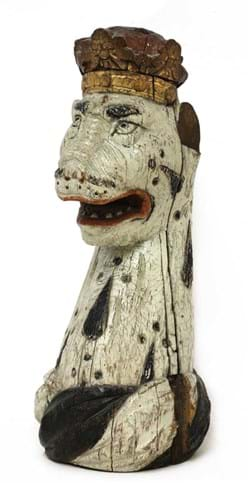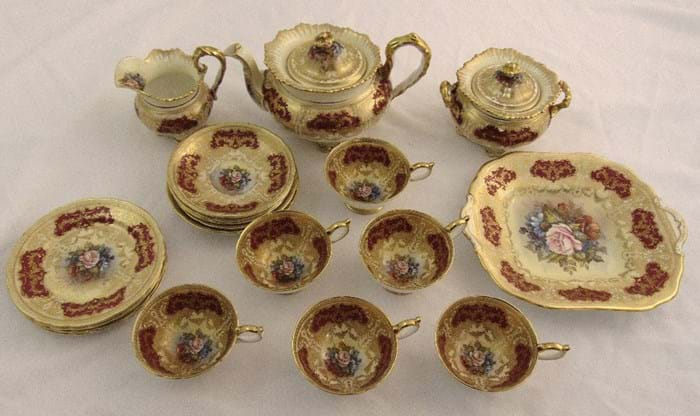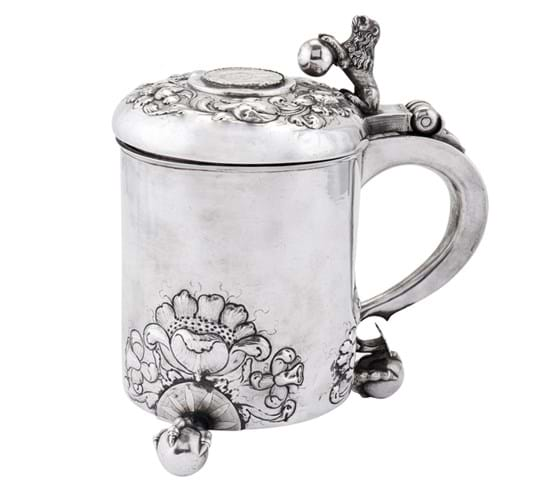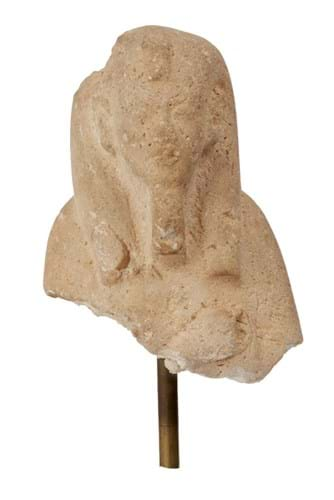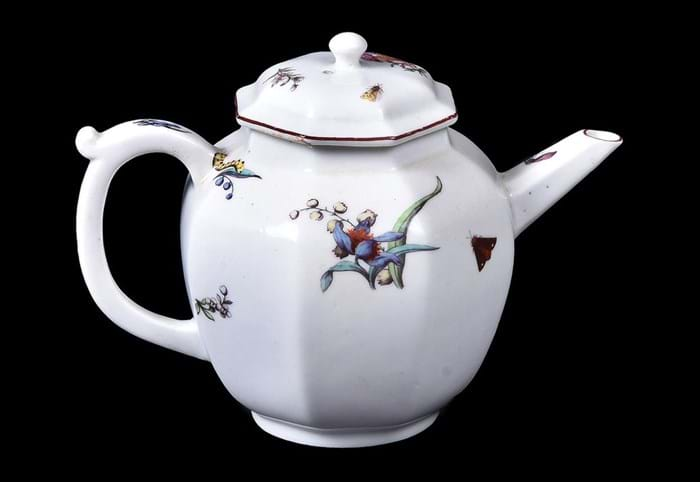1. Armorial leopard’s head – £12,000
This 42cm high carved and painted oak armorial head, pictured above, probably dates to the first quarter of the 16th century – raising the possibility of a connection with one of the great names of the Tudor period.
Assuming the form of a crowned leopard’s head, it bears some similarity to the Boleyn beast which adorned the palaces of Henry VIII from 1533-36, the period in which he was married to his second wife Anne. In a condition consummate with age, it came for sale at Sworders in Stansted Mountfitchet on March 30 from a vendor who had owned it for around 40-50 years.
Estimated at £800-1200, it raised plenty of interest before selling at £12,000.
2. Aynsley tea set – £8600
The best known of the decorators who worked at Aynsley in the 20th century is the flower painter Joseph A Bailey. Employed by the Longton factory for most of his life, from 1937-74, he put his signature to many of firm's better quality ‘cabinet’ wares. Anachronistic bouquets of English garden flowers, and particularly large pink cabbage roses, were his typical stock in trade and they can bring surprisingly high prices. In March 2019 a 21-piece tea service for six sold for £4600 at Arthur Johnson in Nottingham, followed in November 2019 by a bid of £3200 for a similar part set at Special Auction Services.
More spectacular evidence of the commercial appeal of Bailey’s work was provided by Bushey Auctions in Hertfordshire on April 1. This set c.1950 decorated with bouquets of flowers against a red and gilt ground, included a teapot in addition to the cream jug, sugar bowl and other serving pieces. The auction house guided it at £200-300 but bidding reached £8600.
The price is way above anything paid for Aynsley in recent years.
However, back in 2007 a massive Can$48,000 (£22,900) was bid for a 22-piece dessert service decorated with topographical scenes at Waddington's of Toronto. Marked with the factory logo and a design registration code for December 2, 1879, all bore titled scenes based upon Seymour Penson's illustrations in the contemporary Guide Book and Atlas of Muskoka and Parry Sound. It was probably a special commission from the Staffordshire factory, possibly ordered by a lumber baron.
3. Silver peg tankard – £14,000
The name 'peg tankard' is derived from the vertical row of pegs inside that can be used to measure the amount of alcohol drunk as the tankard was passed around the table. The form, made in wood and in silver, was particularly prevalent in Scandinavia.
This Norwegian example with three ball and claw feet and a cast lion sejant and sphere thumbpiece provided the top lot at the silver sale at Chiswick Auctions on March 31. Estimated at £800-1200, it took £14,000 following a battle between Norwegian collectors.
The form and decoration is typical of those made in Bergen in the final third of the 17th century. Floral baroque ornament appeared in Bergen in the 1660s and remained the most popular form of ornament for goldsmith's work until the end of the century.
This vessel, set to the lid with a gilded Christian IV half krone of 1620, dates from c.1690 and carries the maker’s mark PD for Peder Johannesen Reimers (fl. 1670-95). Reimers, the son of Jan Reimers (1610-70), was apprenticed to his father between 1655-60, and entered his mastership in 1670 that allowed him to trade independently.
A very similar coin-set tankard with comparable embossed decoration by Reimers is in the collection of the Norsk Folkemuseum.
Although a surprising result (the tankard had a hole to one of the feet and other condition issues), this is similar to the price achieved for a tankard by Jan Reimers sold from the Peter Gwynn collection at Sotheby’s in 2001 for £15,750.
4. Egyptian fragment – £24,000
The sale of Islamic Art & Antiquities at Roseberys London on March 31 included this New Kingdom yellow quartzite shabti fragment. As the head has survived it is possible to identify the subject with tripartite wig as Akhenaten – the 18th Dynasty pharaoh who reigned from c.1353-1336BC.
He is noted for abandoning Egypt's traditional polytheistic religion in favour of worship centred on the sun gold Aten. After his death, Akhenaten's monuments were dismantled and hidden, his statues were destroyed, and traditional religious practice restored under his successor Tutankhamun.
A better preserved brown quartzite shabti of Akhenaten is in the collection of the Metropolitan Museum of Art. Roseberys fragment was given to the vendor's father by Spink and Sons c.1952, and by repute was acquired in 1910 by the Bishop of Cairo who was a keen amateur Egyptologist.
It was guided at £700-900 but sold at £24,000.
5. Chelsea teapot – £14,000
This unmarked teapot and cover, offered by Dreweatts in Donnington Priory on March 30, dates from the first decade of porcelain production at the Chelsea factory. Almost a decade earlier than catalogued, it was probably made during the Raised Anchor period c.1752.
A number of Chelsea teapots of the same 12.5cm octagonal, form are known carrying a range of different enamelled decoration including kakiemon, puce en came and famille rose.
This example, in fine condition, has botanical decoration of scattered flowers and insects in the manner of Meissen decorator Johann Gottfried Klingler) within brown-line rims. The hammer price bid by a London dealer was £14,000, well above the modest guide of £400-600.


